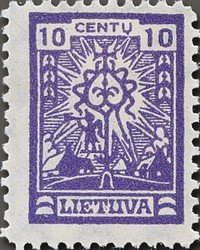Stamp: Crucifix (Lithuania 1923)
Crucifix (Lithuania 1923)
24 February (Lithuania ) within release The first of the new currency standard stamp issue goes into circulation Stamp Crucifix face value 10 Lithuanian centas
| Stamp Crucifix in catalogues | |
|---|---|
| Michel: | Mi:LT 187 |
| Stamp Number: | Sn:LT 165 |
Stamp is square format.
Printing house is unknown. Artist - Adomas Galdikas Sheet of 100 (10x10) There are 16 units of course (!) 60 cents stamps (a variation of 192 C), which are printed on paper spoilage without watermarks A sheet is one such stamp - in the lower part of the sheet Such defective leaf was 16. Since the edges of the leaves were very narrow, some on the left edge left perforated. 20, 25, 50 and 60 cents, and 1 and 5 litas stamps were to go on sale in 1923 February 24, 10 and 15 cents, and 3 litas stamp on 30 October 10, 15, 20 and 60 cents stamps came to an end in 1934 November 1, 1, 3 and 5 litas - 1933 1 October Fakes! 3 and 5 litas stamps manipulated the Post Executive Head of Adolfas Sruoga Stamps were not sold, they are replaced by the actual stock stamps These stamps are called Sruogos counterfeit Stamps printed on the same paper with the same watermarks as the original Perforated punching the same lines. How many different shades of colors and typographic lines around the edges. After the Second World War, some of these characters got to collectors. It is well known 1 and 2 litas (two litas denominations were not!) stamps printed on paper with a watermark, which is a triangle star. Variations: A In the middle of a horizontal unperforated pair B Unperforated left edgeAlso in the issue The first of the new currency standard stamp issue:
- Stamp - Crucifix face value 10;
- Stamp - Crucifix face value 15;
- Stamp - Crucifix face value 20;
- Stamp - Crucifix face value 25;
- Stamp - Castle Kaunas face value 50;
- Stamp - Castle Kaunas face value 60;
- Stamp - church St. Georg, Kaunas face value 1;
- Stamp - church St. Georg, Kaunas face value 5;
|
Data entry completed
60%
|
|
|---|---|
| Stamp Crucifix in digits | |
| Country: | Lithuania |
| Date: | 1923-02-24 |
| Print: | Lithography |
| Perforation: | line 11¼ |
| Emission: | Definitive |
| Format: | Stamp |
| Face Value: | 10 Lithuanian centas |
Stamp Crucifix it reflects the thematic directions:
Religion is any cultural system of designated behaviors and practices, world views, texts, sanctified places, ethics, or organizations, that relate humanity to the supernatural or transcendental. Religions relate humanity to what anthropologist Clifford Geertz has referred to as a cosmic "order of existence". Different religions may or may not contain various elements ranging from the "divine", "sacred things", "faith", a "supernatural being or supernatural beings" or "some sort of ultimacy and transcendence that will provide norms and power for the rest of life". Religious practices may include rituals, sermons, commemoration or veneration (of deities), sacrifices, festivals, feasts, trances, initiations, funerary services, matrimonial services, meditation, prayer, music, art, dance, public service, or other aspects of human culture. Religions have sacred histories and narratives, which may be preserved in sacred scriptures, and symbols and holy places, that aim mostly to give a meaning to life. Religions may contain symbolic stories, which are sometimes said by followers to be true, that have the side purpose of explaining the origin of life, the Universe and other things. Traditionally, faith, in addition to reason, has been considered a source of religious beliefs. There are an estimated 10,000 distinct religions worldwide. About 84% of the world's population is affiliated with one of the five largest religions, namely Christianity, Islam, Hinduism, Buddhism or forms of folk religion.

